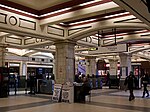
Charles Walter Clark (1885–1972) was an architect who worked for the Metropolitan Railway from 1911 to 1933 and was responsible for designing 25 stations, five of which are listed buildings today.
Career
Born in 1885, he was educated at Emanuel School then worked for a year for the London, Brighton and South Coast Railway before moving to the Met as assistant architect in 1910. After serving in the Royal Naval Volunteer Reserve during World War I, he was appointed Architect by the Metropolitan Railway in 1921. Elected Fellow of the Royal Institute of British Architects in 1930, he did not join the London Passenger Transport Board in 1933 when the Met was absorbed with the other London underground railways. He died in 1972.
Buildings
Between 1911 and 1933 he designed 25 Metropolitan Railway stations, as well as designing houses in Metro-land and Chiltern Court, the large, luxurious block of apartments over Baker Street station, that opened in 1929. Central London stations were built in a Neoclassical style. These included Farringdon, Aldgate, Edgware Road and Paddington (all still extant today) together with Euston Square and Notting Hill Gate (both demolished). Rural stations, such as those at Watford, Croxley, Northwood Hills and Kingsbury were designed to set the tone for the local development. As of 2017, six of these stations are listed buildings, including Baker Street station, which was re-modelled in 1911–13 and is listed Grade II*. One station is listed by the local authority as being of local importance.
List of listed buildings
| Name | Image | Grade | Lines served | Dates | Notes | Map |
|---|---|---|---|---|---|---|
| Baker Street |  |
II* | Circle, Hammersmith & City, Metropolitan | Opened 1863, rebuilt 1911–13 | John Fowler designed the Circle line platforms and the station was rebuilt by Clark. Chiltern Court built above the station in the 1920s, is not included in the listing. | 51°31′19.2″N 0°9′25.2″W / 51.522000°N 0.157000°W / 51.522000; -0.157000 (Baker Street tube station) |
| Croxley |  |
Local | Metropolitan | 1925 | Listed by the local authority | 51°38′51″N 0°26′28.7″W / 51.64750°N 0.441306°W / 51.64750; -0.441306 (Croxley tube station) |
| Farringdon |  |
II | Circle, Hammersmith & City, Metropolitan | Station built 1865, street level buildings re-built 1922 | John Fowler built the original station before it was re-built by Clark | 51°31′12″N 0°6′19.1″W / 51.52000°N 0.105306°W / 51.52000; -0.105306 (Farringdon tube station) |
| Great Portland Street |  |
II | Circle, Hammersmith & City, Metropolitan | Station built 1863, street level buildings re-built 1912 | John Fowler built the original station before it was re-built by Clark | 51°31′25″N 0°08′38″W / 51.523733°N 0.143929°W / 51.523733; -0.143929 (Great Portland Street tube station) |
| Paddington (Praed Street) |  |
II | District, Circle | Station built 1866–68, street level buildings re-built 1915 | John Fowler built the original station before it was re-built by Clark | 51°31′07″N 0°10′46″W / 51.51861°N 0.17944°W / 51.51861; -0.17944 (Paddington station) |
| Watford |  |
II | Metropolitan | c.1925 | Brick built in domestic style to set the tone for the local Metro-land development | 51°39′27″N 0°25′3″W / 51.65750°N 0.41750°W / 51.65750; -0.41750 (Watford tube station) |
| Willesden Green |  |
II | Jubilee | Originally built 1879, street level buildings rebuilt 1925 | Street buildings re-built by Clark | 51°32′57.1″N 0°13′18.1″W / 51.549194°N 0.221694°W / 51.549194; -0.221694 (Willesden Green tube station) |
References
- ^ Jackson, Alan (1986). London's Metropolitan Railway. David & Charles. p. 347. ISBN 0-7153-8839-8.
- Green, Oliver (1987). The London Underground — An illustrated history. Ian Allan. p. 44. ISBN 0-7110-1720-4.
- Ovenden, Mark (2013). London Underground by Design. Penguin Books. p. 38. ISBN 978-1-84614-417-2.
- ^ "Watford". Urban Design. Transport for London. Archived from the original on 5 November 2012. Retrieved 3 May 2013.
- Historic England. "Baker Street Underground Station (Grade II*) (1239815)". National Heritage List for England. Retrieved 2 March 2017.
- "Baker Street". Urban Design. Transport for London. Archived from the original on 9 January 2013. Retrieved 3 May 2013.
- "Croxley". Urban Design. Transport for London. Archived from the original on 7 July 2013. Retrieved 3 May 2013.
- Historic England. "Farringdon Underground Station (Grade II) (1298047)". National Heritage List for England. Retrieved 2 March 2017.
- "Farringdon". Urban Design. Transport for London. Archived from the original on 16 August 2012. Retrieved 3 May 2013.
- Historic England. "Great Portland Street Underground Station (Grade II) (1213650)". National Heritage List for England. Retrieved 2 March 2017.
- Historic England. "Paddington Underground Station (Grade II) (1392020)". National Heritage List for England. Retrieved 2 March 2017.
- "Paddington". Urban Design. Transport for London. Archived from the original on 16 August 2012. Retrieved 3 May 2013.
- Historic England. "Watford Underground Station (Grade II) (1393965)". National Heritage List for England. Retrieved 2 March 2017.
- Historic England. "Willesden Green Underground Station (Grade II) (1391808)". National Heritage List for England. Retrieved 2 March 2017.
- "Willesden Green". Urban Design. Transport for London. Archived from the original on 16 August 2012. Retrieved 3 May 2013.
External links
- London Transport Museum Photographic Archive (search results for 'Charles W Clark')
Download coordinates as:
Categories: